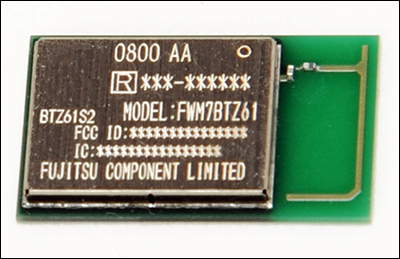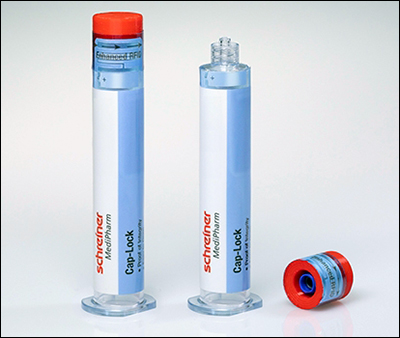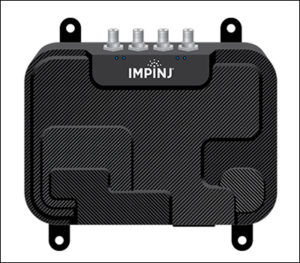Presented here are recent news announcements regarding the following organizations: Fujitsu, Schreiner MediPharm, IntelliGuard, NXP, Xiaomi, the LoRa Alliance, PLI Card Marketing Solutions, and Impinj.
Fujitsu Launches Bluetooth 5.0 Dual-Mode Wireless Modules
Fujitsu Components America has announced its FWM7BTZ61 Bluetooth 5.0 dual-mode wireless radio modules, which are compatible with both Bluetooth Low Energy (BLE) and legacy Bluetooth Classic (basic rate or enhanced data rate), allowing designers to choose between the two modes with a single module. The FWM7BTZ61 modules are powered by Cypress Semiconductor‘s CYW20819 system-on-chip, feature BLE profile and Bluetooth Classic (BR/EDR) power class 2 capabilities, and support Bluetooth 5.0’s X2 communication.
 The modules’ symbol and data rates accommodate 1Mbps and 2Mbps to facilitate communication with other BLE devices. Classic mode supports 1Mbps BR, as well as 2Mbps and 3Mbps EDR communication, and also supports operating voltages ranging from 1.71 to 3.63 volts, enabling mating with various system design and power supply conditions. To accommodate different design needs, the portfolio includes two certified models.
The modules’ symbol and data rates accommodate 1Mbps and 2Mbps to facilitate communication with other BLE devices. Classic mode supports 1Mbps BR, as well as 2Mbps and 3Mbps EDR communication, and also supports operating voltages ranging from 1.71 to 3.63 volts, enabling mating with various system design and power supply conditions. To accommodate different design needs, the portfolio includes two certified models.
One contains serial port profile for Bluetooth Classic and GATT profile for BLE. SPP is the most common profile for serial communication applications, while GATT enables Bluetooth communications with other modules through the GATT layer in the module by using a simple text command via UART. One model replaces the GATT Direct Access profile with Fujitsu Components’ embedded firmware, which enables simple text-based commands via UART to control all Bluetooth commands and parameters, and simplifies a customer’s firmware development.
The modules can be connected to Apple‘s Authentication 3.0 Coprocessor to send and receive data with application software on iOS devices. Limited samples are available now and orders will be accepted in January 2021.
Schreiner MediPharm Adds RFID to Security Labels
Schreiner MediPharm, a German provider of label solutions for the healthcare industry, has added an RFID inlay to its Cap-Lock tamper-evident specialty labels. Designed to help hospitals expand digitization initiatives, the label-and-cap security concept for prefilled syringes enables automated inventory and supply chain management, as well as digital first-opening indication.
Equipping syringes containing liquid medications with RFID labels poses a challenge, the company reports, since the container material and the composition of the liquid may impair UHF RFID label reading. Flag labels protruding from a container are frequently used for this purpose, but they can be torn off, require additional space and need to be manually applied. With the Cap-Lock, the firm explains, the RFID chip is integrated in the label. The Cap-Lock includes a cap adapter and a label; the adapter is placed on top of the syringe’s primary closure and is interlinked with it to equalize the diameter differences of the syringe body and closure.
 The label wraps around the syringe body and the cap adapter. Once opened, it provides irreversible tamper evidence due to an integrated perforation. The RFID inlay is located in the upper part of the label at the cap’s level. Thus, it largely sits outside the liquid-filled area and enables long-range reading. With the RFID functionality, digital first-opening evidence is made possible, in addition to the visual first-opening indication provided by the destroyed label. The RFID label can be automatically processed as part of the primary container’s normal labeling workflow.
The label wraps around the syringe body and the cap adapter. Once opened, it provides irreversible tamper evidence due to an integrated perforation. The RFID inlay is located in the upper part of the label at the cap’s level. Thus, it largely sits outside the liquid-filled area and enables long-range reading. With the RFID functionality, digital first-opening evidence is made possible, in addition to the visual first-opening indication provided by the destroyed label. The RFID label can be automatically processed as part of the primary container’s normal labeling workflow.
For live monitoring and control of the logistics flow of materials and products in automated inventory and supply chain management, the data of syringes equipped with RFID labels can be automatically captured at various stations. As a result of reading the picked and placed products, current inventory information is consistently stored in a database. Integrity, first-opening and tampering with containers can be digitally monitored.
For medication management, data stored on the RFID labels, such as product name, manufacturer, batch number and expiration date, can be read automatically, either individually or in bulk, using handheld or specialty readers and matched with a database. This enables the exact tracking of inventory and provides transparency regarding medicines that are missing or approaching their expiration date.
IntelliGuard Offers Platform to Read GS1 RFID Drug Labels
IntelliGuard, a provider of RFID medication management technologies, has announced the release of GS1 readability capabilities. The ability to read GS1 labels, the company explains, means that any medication with a compliant RFID smart label is compatible with its medication-management technology, providing real-time inventory management, product location and identification. GS1-standard readership capabilities enable IntelliGuard’s medication automation technologies to read a wider range of RFID smart labels.
“As the first RFID vendor with the ability to read the portfolio of Fresenius Kabi RFID smart labels that adhere to GS1 standards, we are proud of what this partnership means for the industry,” said Gordon Krass, IntelliGuard’s CEO, in a prepared statement. “By providing the software and hardware necessary for reading medication with RFID smart labels already associated with critical medication data, we are saving our clients valuable time and labor. We are paving the way for an open, global RFID standard that dramatically improves healthcare inventory management and interoperability.”
Pharmaceutical manufacturer Fresenius Kabi recently announced that RFID-based smart medication labels will be introduced to its range of medications, facilitating interoperability and compatibility with IntelliGuard’s GS1 readability services. The resulting integration is operational in Fresenius Kabi’s Diprivan (Propofol) 200 mg per 20 mL (10 mg per mL) Injectable Emulsion.
GS1 develops global standards for barcodes and has helped to create a common language for business communication. Its standards for RFID are intended to enable tighter control over the drug supply chain—a driving factor for government agencies such as the FDA in promoting the use of RFID tags on packages to identify counterfeit drugs.
NXP, Xiaomi Offer NFC Stickers for Smart-Home Use
NXP Semiconductors and Xiaomi have announced that Xiaomi’s PonPon Tile 2.0 stickers are powered by NXP’s NTAG NFC chip technology. The PonPon stickers and Xiaomi’s Mijia (Mi Home) app work with numerous Mi smart-home devices, such as lighting, security cameras, alarm clocks and entertainment systems. Configuring and managing the devices is accomplished via a tap of an NFC-enabled smartphone.
“NXP is an important partner of Xiaomi, as we share a common goal to provide people with a smarter, safer and more convenient life through technology,” said Fan Dian, Xiaomi’s GM of IoT and chairman of the AIoT Technical Committee, in a prepared statement. “In the past decade, many of Xiaomi’s innovations could not have been achieved without NXP’s strong support, and Xiaomi will continue working with NXP in the future to bring more exciting technology to people’s lives.”
 To set up smart-home devices, users can configure tasks using Xiaomi’s PonPon Tile 2.0 stickers and the Mijia mobile app, which links to Xiaomi’s IoT platform to interpret commands and transfer instructions to the devices. The PonPon Tile 2.0 stickers support the configuration of single and multiple tasks, along with Wi-Fi and Bluetooth paring for smart nodes. Users can tap a phone running the Mijia app to trigger, configure and modify actions in their smart home. After placing the stickers in multiple locations throughout the home, they can tap to access their custom settings.
To set up smart-home devices, users can configure tasks using Xiaomi’s PonPon Tile 2.0 stickers and the Mijia mobile app, which links to Xiaomi’s IoT platform to interpret commands and transfer instructions to the devices. The PonPon Tile 2.0 stickers support the configuration of single and multiple tasks, along with Wi-Fi and Bluetooth paring for smart nodes. Users can tap a phone running the Mijia app to trigger, configure and modify actions in their smart home. After placing the stickers in multiple locations throughout the home, they can tap to access their custom settings.
The app and stickers allow users to add new smart-home devices with a few clicks, control the devices from anywhere with their phone, orchestrate multiple devices for a set of tasks, obtain the status of different devices in real time and share access to smart devices with others. The stickers and app allow users to configure multiple smart-home devices to work together to accomplish combined tasks at specific times. Based on their preferences, they can create different scenarios for welcome-home, away-from-home and other settings, such as dimming or turning off lights, locking doors, setting playlists and alarms, and waking up a television. The PonPon Tile 2.0 solution is designed to reduce complexity for users, simplifying setup processes.
“NXP offers a leading portfolio of end-to-end NFC solutions for linking the digital and physical worlds with an extensive range of hardware, software, security and service solutions,” said Philippe Dubois, NXP’s VP and GM of IoT security and smart mobility and retail, in the prepared statement. “For over ten years, NXP and Xiaomi have been collaborating on mobile payments, intelligent audio, fast charging solutions, secure IoT and much more. PonPon Tile 2.0 stickers have been developed as a smart shortcut for easy access and use of all Mi Home devices, enhancing peoples’ comfort, safety and entertainment throughout the home.”
LoRa Alliance Releases New Spec
The LoRa Alliance, a global association of companies backing the open LoRaWAN standard for IoT LPWANs, has announced its LoRaWAN TS1-1.0.4 Link Layer (L2) specification. This latest definition of the LoRaWAN standard includes all required implementation elements to facilitate LoRaWAN deployments. According to industry research firm IoT Analytics, LoRaWAN is the most adopted LPWAN technology to date, representing more than one third of all deployments globally. This market is expected to grow at an annualized rate of 42 percent during the next five years.
“One of the key goals of the LoRa Alliance has been the simplification of end-to-end deployments for the internet of things,” said Donna Moore, the LoRa Alliance’s CEO and chairwoman, in a prepared statement. “Today, I am proud to announce we have achieved this goal with the release of the LoRaWAN TS1-1.0.4 specification. Our focus, as we developed this update to the specification, was to ensure that it would provide every element needed for easy development, certification testing and deployment. This complete package will further accelerate mass IoT and support our members and end users as they roll out their LoRaWAN solutions worldwide.”
The package includes the LoRaWAN TS1-1.0.4 L2 spec; LoRaWAN TS1-1.0.4 Certification requirements document and Program; LoRaWAN TS1-1.0.4 LoRaWAN Certification Test Tool (LCTT) update for end-device pre-certification and regression tests; LoRaWAN TS1-1.0.4 Reference Code for end devices, which meets certification; and the LoRaWAN TS1-1.0.4 LoRaWAN Certification Protocol (TS009). It accelerates development with LoRaWAN by providing a predefined reference implementation that can serve as an example or starting point to develop a product.
Once a product is ready, a developer can verify that it meets LoRaWAN certification requirements using the LCTT before seeking formal certification. The package was created against Regional Parameters RP2-1.0.1, which is part of the LoRaWAN TS1-1.0.4 package. The update to the LoRaWAN TS1-1.0.4 L2 specification includes clarifications that ensure interoperability while simplifying the development, deployment and management of LoRaWAN networks, and new security features augment the protocol’s security.
Changes implemented in the package include normative and grammatical clarification; the renaming of some terms and identifiers to clarify their use; the clarification of Class A RX window opening requirements; full reference to the Regional Parameters companion document; improvements and clarification to ADR behaviors, including back-off examples; MAC command handling and a persisted MAC commands overview, including priority of responses; and more.
PLI Unveils RFID Hotel Keys Made With Recycled Materials
PLI Card Marketing Solutions, a provider of key cards and hospitality marketing programs, has introduced 100 percent PVC-free RFID cards designed with the durability and performance of standard PVC. PLI’s plastic cards and marketing solutions support brands in the hospitality, retail, entertainment and related industries.
The compny’s Re.Solve rPETG guest key cards for RFID lock systems are compliant with the ISO/IEC 14443 and ISO/IEC 10373-1 standards, the company reports. The cards are constructed primarily from PET-G resin, with 75 percent pre-consumer recycled content. The key environmental advantage of PET-G over PVC, according to the company, is the absence of hazardous substances.
The Re.Solve rPETG reduces first-use plastic consumption and waste-to-landfill by upcycling materials at the source of production. “Brands are setting ambitious sustainability goals for 2030,” said Andy Wersel, PLI’s senior VP of sales, in a prepared statement. “At PLI, we are committed to providing solutions like Re.Solve rPETG that enable brands and empower those consumers who are concerned about sustainability.”
Robert Kotseos, PLI’s VP of hospitality, added in the prepared statement, “Re.Solve rPETG is the latest addition to PLI’s portfolio of sustainable key card solutions. It joins Re.Solve TF and Re.Solve Mag—both 100 percent plastic-free—which were introduced earlier this summer. We encourage any hotel looking for sustainable hotel keys to reach out to our live customer support team for samples.”
Impinj Intros RFID Reader for IoT
Impinj has announced that its R700 RFID reader is available globally, with a new reader model offering support for global frequency bands, including FCC. The company reports that its latest offering allows users to reduce the complexity of deploying multinational enterprise RFID solutions.
 The R700 has been tested and deployed since it was first announced in February 2020. It offers enterprise-grade reliability and security, the company reports, as well as support for numerous RFID tags, simplifying deployments for global Internet of Things (IoT)-bsaed solutions. The system comes with developer tools to speed up time-to-solution for the company’s partners and end customers.
The R700 has been tested and deployed since it was first announced in February 2020. It offers enterprise-grade reliability and security, the company reports, as well as support for numerous RFID tags, simplifying deployments for global Internet of Things (IoT)-bsaed solutions. The system comes with developer tools to speed up time-to-solution for the company’s partners and end customers.
Developers new to RFID can build and deploy customized solutions by using an IoT device interface that includes a reader configuration REST API and a Web UI. This allows IoT developers to connect applications in order to configure, control and consume RFID data. With native support for various data formats and protocols, such as MQTT, the interface enables users to scale and design solutions able to be integrated with IoT platforms.
The R700 RFID reader is currently available in two models. An ETSI reader model for 32 E.U. countries includes support for both the 865 to 868 MHz and 915 to 921 MHz frequency bands. And a global reader model includes support for 902 to 928 MHz, for use in the United States and in other countries that utilize parts of this band.


